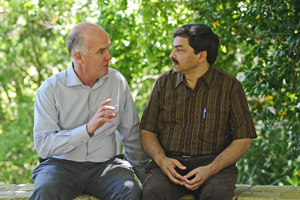Long-term collaborators forge ahead in the fight against heart disease
29 November 2012 | Story by Newsroom Working together: Prof Ed Sturrock and ProfRavi Acharya, research collaborators for the last 17 years, got some valuable face-time at the first H3-D Symposium, which focused on their speciality, cardiovascular disease.
Working together: Prof Ed Sturrock and ProfRavi Acharya, research collaborators for the last 17 years, got some valuable face-time at the first H3-D Symposium, which focused on their speciality, cardiovascular disease.
It's become a tenet of scientific research that collaboration is crucial, but even more so when the research is aimed at developing drugs to combat cardiovascular disease, ranked among the leading causes of death in South Africa.
Professors Ed Sturrock of UCT and Ravi Acharya of the University of Bath are long-standing collaborators in exactly this field, having worked together since 1995. Their research revolves around angiotensin-I converting enzyme (ACE), a key regulator of blood pressure and thus an important drug target in the treatment of cardiovascular disease.
Sturrock, a principal investigator in UCT's Institute of Infectious Disease and Molecular Medicine, or IIDMM, describes his relationship with Acharya as "collaboration in the true sense of the word in that both parties have contributed equally".
"The various milestones in ACE biology could not have been achieved without contributions from both parties," he adds.
The sum of their efforts resulted in 20 joint peer-reviewed articles and more than 34 structures - ie 3D structural data of molecules - that have been deposited in the international Protein Data Bank of the Research Collaboratory for Structural Bioinformatics, or RCSB. Recently, Sturrock and Acharya published their work on the 3D molecular structures of two peptides (including one from snake venom) that inhibit ACE in the Scientific Reports of the prestigious Nature Publishing Group. This study posits a new mechanism for the control of ACE.
"This work together with my collaboration with Professor Kelly Chibale [director of UCT's H3-D Drug Discovery and Development Centre] on the design and synthesis of novel domain-selective ACE inhibitors has forged a strong foundation for the production of new ACE inhibitors for the development of (among others) antihypertensive drugs," says Sturrock.
 This work is licensed under a Creative Commons Attribution-NoDerivatives 4.0 International License.
This work is licensed under a Creative Commons Attribution-NoDerivatives 4.0 International License.
Please view the republishing articles page for more information.










